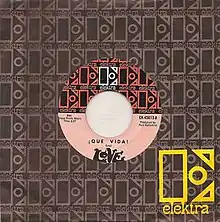| "¡Que Vida!" | ||||
|---|---|---|---|---|
 US issue | ||||
| Single by Love | ||||
| from the album Da Capo | ||||
| B-side | "Hey Joe" | |||
| Released | March 1967 | |||
| Recorded | September 29, 1966[1] | |||
| Studio | RCA Studios, Hollywood, Los Angeles | |||
| Genre | ||||
| Length | 3:37 | |||
| Label | Elektra | |||
| Songwriter(s) | Arthur Lee | |||
| Producer(s) | Paul A. Rothchild | |||
| Love singles chronology | ||||
| ||||
"¡Que Vida!" is a song written by Arthur Lee and first released in 1967 by the band Love. It was released both on Love's album Da Capo and as a single, backed with "Hey Joe". It has also been included on several Love compilation albums.
Composition
The song's title is Spanish for "What a Life", though the working title for the song was "With Pictures and Words".[2] The lyrics, involving topics such as death and reincarnation, suggest to Hoskyns "bad-trip paranoia" and to Greenwald "a psychedelic state of mind".[3][4] Music critic Richie Unterberger claims that in the song "Lee's Johnny Mathis inclinations start to flower in a series of question and answer lyrics."[5] The melody is based on the 1965 song "Lifetime of Loneliness" by Burt Bacharach and Hal David.[2][6][7] It employs a rhythm, described by author Bob Cianci as a "lilting Latin rhythm."[3][8] It also incorporates sound effects such as sleigh bells, merry-go-round music and a popping champagne cork.[2][9] Arthur Lee biographer John Einerson describes Lee's vocal tone on the song as "mellow".[2] As described by author Barney Hoskyns, the song uses "Latin rhythms and cool jazz shadings to fashion a kind of spaced-out MOR."[4] Music critic Fredrik Eriksen feels the song sounds like a mixture of The Rolling Stones and Jefferson Airplane.[10]
Reception
AllMusic critic Matthew Greenwald regard "¡Que Vida!" as a "true groundbreaking composition for Arthur Lee" in the way the allows the song to flow freely in the direction it wants to go.[3] Greenwald also notes that although the chords always resolve, they go in surprising directions.[3] Edna Gundersen and Ken Burns of USA Today described the song as "summery jazz-pop".[11] Sean Elder of Salon calls the song "whimsical" and notes that it "almost seems like a parody of a hippie song, punctuated with what sounds like a pop gun."[12]
References
- ↑ "Music Collectors pages - Love (Da Capo)". Chrome Oxide.
- 1 2 3 4 Einarson, J. (2010). Forever Changes: Arthur Lee and the Book of Love. Jawbone Press. p. 142. ISBN 9781906002312.
- 1 2 3 4 Greenwald, M. "¡Que Vida!". AllMusic. Retrieved 2012-07-09.
- 1 2 Hoskyns, B. (2009). Waiting for the Sun: A Rock 'n' Roll History of Los Angeles. Hal Leonard. p. 123. ISBN 9780879309435.
- ↑ Unterberger, R. (1998). Unknown Legends of Rock 'n' Roll. Hal Leonard. p. 139. ISBN 9780879305345.
- ↑ Greenwald, M. "Lifetime of Loneliness". Allmusic. Retrieved 2012-07-09.
- ↑ Kent, N. (January 27, 1999). "Bryan McLean (Love) – Le malaimé". Les Inrockuptibles (in French). Retrieved 2012-07-09.
- ↑ Cianci, B. (2006). Great Rock Drummers of the Sixies. Hal Leonard. p. 135. ISBN 9780634099250.
- ↑ "Crawdaddy, Volumes 10-23". Crawdaddy. Vol. 10–23. Crawdaddy Publishing Company. 1967.
- ↑ Eriksen, F. (April 14, 2003). "The Best of Love". Groove.no. Retrieved July 9, 2012.
- ↑ Gundersen, E. & Barnes, K. (July 18, 2007). "20 albums that defined an era". USA Today. p. D5.
- ↑ Elder, S. (May 22, 1999). "Love's Labors Lost". Salon. Retrieved 2012-07-09.